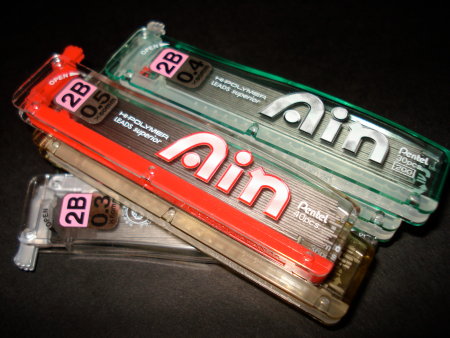
Hmm, has anyone noticed this aspect of mechanical pencil refills?
Pentel Ain refills (just to pick a particular brand) are all the same price.
And all are 60mm in length.
But they contain:
0.3mm – 20 pieces
0.4mm – 30 pieces
0.5mm – 40 pieces
0.7mm – 40 pieces
0.9mm – 36 pieces
What gives? Thinner lead costs more? I would think one would get more pieces of thin lead per dollar.
If you calculate volume = length * pi * radius * radius
Then single pieces of lead are:
0.3mm = 60mm * 3.14 * 0.15mm * 0.15mm = 4.24mm3
0.4mm = 60mm * 3.14 * 0.20mm * 0.20mm = 7.54mm3
0.5mm = 60mm * 3.14 * 0.25mm * 0.25mm = 11.78mm3
0.7mm = 60mm * 3.14 * 0.35mm * 0.35mm = 23.08mm3
0.9mm = 60mm * 3.14 * 0.45mm* 0.45mm = 38.16mm3
That’s right – a 0.9mm lead is 9 times the volume of a 0.3mm lead! (Which makes sense as the volume is proportional to the square of the three-times-larger radius.)
So as to how much lead is in a Pentel Ain box:
0.3mm: 20 * 4.24mm3 = 84.80mm3
0.4mm: 30 * 7.54mm3 = 226.20mm3
0.5mm: 40 * 11.78mm3 = 471.20mm3
0.7mm: 40 * 23.08mm3 = 923.20mm3
0.9mm: 36 * 38.16mm3 = 1373.76mm3
That’s right – for the same price, a 0.9mm user gets 16 times more lead in a box than a 0.3mm user!
Curious?

It’s simple supply and demand. .5 and .7 are by far the most common widths, so more are produced, leading to a lower price per lead. To maintain the same cost per package, they really have no choice but to shrink the number of leads in the less common widths.
My intuition is that material costs are negligible; although, the 0.9 mm may be pushing it when compared to the 0.3 mm. I agree with Mike about cost reduction due to larger production runs but would add that the smaller leads are probably harder to manufacture. There is probably more breakage and, again this is just intuition, the machinery is probably more finicky.
Yup, most likely the thinner, more fragile lead is harder to deal with, both in manufacturing and shipping. Also, I think it’s a fallacy to suppose that 9 times more lead means 9 times more writing. I personally find that I use different sized leads in a similar amount of time, with the difference being in the stroke on the paper (broad vs. thin). I think I go through a thicker lead a *bit* slower, but not by much.
All plausible explanations. Personally I have yet to use up a single entire AIN lead box, so i hadn’t really stop to consider this issue. Each tube seems to last me forever.
Its an interesting topic, but personally I would agree with che pablo that the cost of the leads is negligible or irrelevant. I imagine the fancy ain tube costs more than its contents. Its seems possible that 0.3mm is actually more expensive than 0.5mm due to breakage, etc. So, I’d fugure its marketing and sales ideas on how many leads they should stick in the tube rather than cost factors.
Perhaps it’s an effort to rationalize production runs of the various diameters. Lead gets in touch with Sales and determines that 0.3mm should be manufactured at .xx the rate of the common sizes. It may be that most 0.3mm pencils are purchased for technical and professional use, that they are essential tools in specialized trades for which there is a known limited but strong demand for refills. In other words, the manufacturers have these users over a barrel; these consumers have to keep buying this lead because for their purposes a larger diameter just won’t do. On the chubby end of the lead scale perhaps it is art hobbyists and crossword and sudoku puzzle enthusiasts who drive the demand, albeit a demand just a tad less significant than that for the common middle sizes.
Anymore, I’m just happy to find leads in various sizes and hardnesses. Luckily, I’ve got “one each” of just about every Pentel lead, and a decent collection of other brands.
I also agree with the 0.3mm and 0.4 being harder to produce due to the diamater and how fragile they are.
Because most of my lead ends up in my friends’ pencils during tests I rarely bother to buy premium 0.5mm lead, except for my Uni M-552s that never leave my room.
Interesting though, Staples sells a Staedtler 925 03 for $4ish and a pack of the 925 05 and 07 for $15. Which means it is cheaper to buy a 925 03. However, they don’t sell 0.3mm lead (I haven’t seen a place that does).
Here in the UK, we have a similar situation with Pilot’s ENO leads. There are the same number of leads in each pack (12), but the 0.3mm leads sell at a higher price.
Faber-Castell leads have the same number in the 0.35mm packs, and cost the same. Their 1.4mm leads, though, have half the number of leads, for more money.
I NEED PENCIL REFILLS
I AM FROM SRI LANKA PL SEND QUATATION
Great looking tubes those AIN – except trying to get lead out of them is like trying to pull a tooth. Most of the time you want to put a good few into the lead compartment- this one at a time method takes ages.
The cost for an amount of lead is even more if you consider 0.2mm leads which are about $5.00 for a 12 lead pack.
That’s 22.62mm3 of lead for a higher price per pack.